This is a Kodak Retina IIc rangefinder camera built by Kodak AG, the German subsidiary of the Eastman Kodak company. The IIc was the successor to the Retina IIa and while on the surface is a very similar model, there are many cosmetic and functional improvements that make it an entirely different camera. Some of the major differences are that it has an interchangeable lens mount, a bottom mount film advance, a coupled EV scale for aperture and shutter speed selection, and a completely revised front door / lens mount. Many Retina collectors consider the IIc to be the pinnacle of the entire Retina series, offering the best features in a small and easy to use size.
Film Type: 135 (35mm)
Lens: 50mm f/2.8 coated Schneider-Kreuznach Retina Xenon 6 elements
Focus: 2.5′ to Infinity
Type: Coupled Rangefinder
Shutter: Compur Leaf
Speeds: B, 1 – 1/500 seconds
Exposure Meter: None
Battery: None
Flash Mount: Coldshoe and PC Sync
Manual: http://www.cameramanuals.org/kodak_pdf/kodak_retina_iic_small.pdf
History
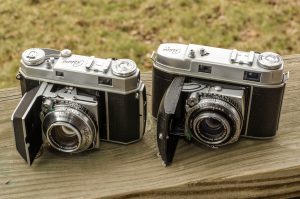
When I first acquired this Retina IIc, I didn’t think there would be enough information to make a whole review for this specific camera. I had intended to update my earlier review of the Kodak IIa and combine both models into a single review, similar to what I did for the Kodak 35 and Kodak 35 RF models. After handling the camera and really getting familiar with it’s design and features, I discovered that the IIc is a unique enough model to warrant it’s own review.
If you read the review of the Kodak Retina IIa, I go a little more in depth into Kodak’s history and why they created the Retina line, so I won’t duplicate that information here, but I will start out with a chronology of the Retina line.
For many collectors, keeping track of all of the different models and sub models could get a bit confusing. Thankfully, Kodak wisely created their own numbering system which uniquely identifies each Retina model with a 3 digit number. Models from before the war have completely different “type” numbers than ones after the war. As each new model was introduced, a new number was assigned to it.
| Prewar | Postwar | ||||
| Retina | 1934-35 | Type 117 & 118 | Retina I | 1945-48 | Type 010 |
| Retina I (Black) | 1936-38 | Type 119 | Retina I | 1949-50 | Type 013 |
| Retina I (Black) | 1939-41 | Type 149 | Retina I | 1951-53 | Type 015 |
| Retina I (Chrome) | 1936-38 | Type 126 | Retina I | 1954-56 | Type 018 |
| Retina I (Chrome) | 1939-41 | Type 148 | Retina I | 1957-60 | Type 019 |
| Retina II | 1936 | Type 122 | Retina II | 1945-48 | Type 011 |
| Retina II | 1937-38 | Type 142 | Retina II | 1949-50 | Type 014 |
| Retina IIa | 1939-41 | Type 150 | Retina IIa | 1951-53 | Type 016 |
| Retina IIc | 1954-56 | Type 020 | |||
| Retina IIC | 1957-58 | Type 029 | |||
| Retina IIIc | 1954-56 | Type 021 | |||
| Retina IIIC | 1957-60 | Type 028 |
The IIc is the successor to the IIa and was in production for 3 years before being replaced by the IIC. Changes from the IIa include a completely new door latch and shutter rack system which is not only more reliable, but the bellows is no longer exposed on the newer model, further protecting it from the ravages of use and time. The viewfinder has brightlines in it to accurately portray the 50mm image size. Both windows are marginally larger, but not enough to make a huge difference. The IIc has an all new frame counter system that required the wind lever to be moved to the bottom of the camera. The frame counter still counts down from 36 to 0 like other Retinas, but the new design is said to be more robust and less likely to fail like on the earlier IIa. There is also a new coupled light value scale which is said to help the photographer pick an appropriate shutter speed and aperture value based off available light. I talk more about my thoughts on this later in the review.
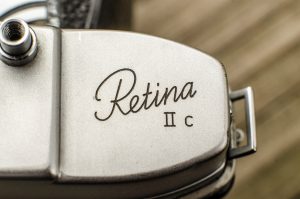
Finally, the last major change was a partially interchangeable lens mount. I say ‘partially’ because you can only swap the front elements. There are rear lens elements behind the shutter that stay put. This means that when changing lenses on the Retina, you are limited the ones specifically designed for these models. You must stick with lenses made by the same company. If your Retina has Schneider lenses, they must all be Schneider.
The IIc was succeeded by the IIC (often referred to as the “big C”), which can be confusing to those not familiar with the Retina family. The difference between a “small c” and “big C” Retina is that the “big C” model has a much larger and brighter viewfinder with brightlines for 35mm, 50mm, and 80mm lenses. To house the larger viewfinder, the top plate is slightly taller and flat all the way across (losing the stepped plate from the “small c”). Otherwise, both “c” models have the same interchangeable lens mount, bottom film wind, and improved door latch/shutter rack system which improved reliability from the IIa model.
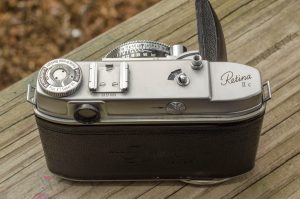
Every collector has their own favorite Retina, but many people prefer the IIc as it still retains the small and compact size of the earlier models, but has a more reliable design that doesn’t fall victim to some of the same problems that often plagues the IIa. The IIIc and IIIC models are identical to their IIc and IIC counterparts, except that they add a coupled selenium light meter.
As I said in my review for the Retina IIa, the entire Retina line has a large following among collectors and vintage photographers alike. Every Retina from the very first model in 1934 to the Retinettes of the 1960s were well built and had great optics. It is hard to use one of these cameras and not get great results from them. They’re compact and well built cameras that when taken care of, are equally as capable of excellent shots in 2016 as they were 60+ years ago when they were first made.
Repairs
Although this Retina IIc was in better physical condition than my IIa, it had an extremely foggy viewfinder. It was very hard use the rangefinder in all but the brightest lighting conditions. How could a camera in such great physical and operational shape have such a dirty viewfinder? I had to correct this.
Before I go any further, its worth noting that the Retinas have a reputation as being extremely difficult to work on. Like many German cameras, they are over-engineered devices built with the highest standards for quality. As such, doing any level of work inside of a Retina is not for the fainthearted.
Chris Sherlock is probably the world’s authority on servicing and repairing Retinas and his website has a ton of useful information for DIYers like myself. If however, you decide that you don’t want to attempt a repair, he has a repair service where he will fix pretty much any problem on any model of Retina. His standard CLA service for a Retina IIc like mine is around $100 USD not including shipping. Obviously, repair prices will vary depending on model and complexity of the problem, but his work comes highly recommended. I have never heard of anyone who has sent him a Retina, come back disappointed.
My Retina IIc did not need a full CLA as the shutter was working perfectly, the cocking mechanism was working, and the frame counter worked (all common problems with Retinas). The only issue was a dirty viewfinder. His site has detailed instructions for getting the top plate off, and it is really simple. There are only 3 screws holding the top plate on the camera. Two of them are under the rewind knob, and the third is on the right side of the camera. Removing the rewind knob requires a lens spanner, but otherwise comes off like any other rewind knob on most cameras. See the red arrows in the image to the left for the position of the 3 screws.
Chris Sherlock’s tutorial makes special mention to not allow the metal shaft under the shutter release button come out. Apparently if this happens, it is very difficult to reinstall. He suggests holding it in place with a rubber band. As long as you do not turn the camera upside down, it shouldn’t move. You might notice that the button for the frame counter has fallen out. This is OK and easy to reinstall later on.
Once the top plate is off, you can see the rangefinder assembly. What is interesting about the Retina is that the rangefinder and all viewing windows is one single self contained module. It is attached to the top of the camera via 2 screws.  Look at the image to the right, and the screws are in the recessed holes indicated by the yellow arrows.
Look at the image to the right, and the screws are in the recessed holes indicated by the yellow arrows.
The rear eye piece is held in position by a black metal plate which is held in place by a single screw which is indicated by the blue arrow. If you want to clean the rear eye piece, remove the screw and the black plate will come off. Be careful as the rear eye piece can fall out at this point. It is a round piece of glass that is very fragile. When inserting this piece of glass back into the camera, make sure the flat side of the glass is facing out and the convex side is facing in. You can also see the rangefinder prism (indicated by the red arrow). You should clean this prism to make sure no debris is on it.
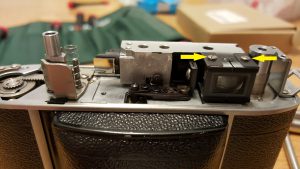 The picture to the left shows the rangefinder assembly still attached to the camera, but at this point, you should have it removed from the camera. The next step is to remove two black metal brackets which are above the front viewfinder window. Each of the black metal brackets are held in place by one screw each, indicated in the picture to the left by yellow arrows. Remove these screws and the black brackets and now you have access to the glass inside of the viewfinder.
The picture to the left shows the rangefinder assembly still attached to the camera, but at this point, you should have it removed from the camera. The next step is to remove two black metal brackets which are above the front viewfinder window. Each of the black metal brackets are held in place by one screw each, indicated in the picture to the left by yellow arrows. Remove these screws and the black brackets and now you have access to the glass inside of the viewfinder.
The image to the right shows the side of the rangefinder assembly with the black bracket still in place. You should have this removed at this point, but for the purposes of this walk through, I can still show you what you need to do.
Not shown is the rear eye piece which I talked about earlier, and also not shown is the beamsplitter which is a tinted diagonal mirror. Like all b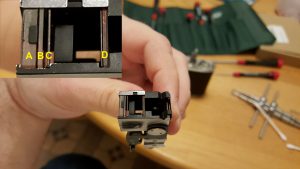 eamsplitters, the coating on them is very fragile. Do not attempt to remove the beamsplitter and be very careful when trying to clean it. Do not use any chemicals or fluids on a beamsplitter. If there is some dust on it, blow it off with some gentle air from a blower. Do not use compressed air in a can as solvents can sometimes come out of the can staining the glass. If you absolutely must, gently drag a dry Q-tip over the surface of the beamsplitter to remove bigger debris. Some people will tell you to never touch a beamsplitter. I’ve gently wiped several using this method and have never had a problem, but do so at your own risk.
eamsplitters, the coating on them is very fragile. Do not attempt to remove the beamsplitter and be very careful when trying to clean it. Do not use any chemicals or fluids on a beamsplitter. If there is some dust on it, blow it off with some gentle air from a blower. Do not use compressed air in a can as solvents can sometimes come out of the can staining the glass. If you absolutely must, gently drag a dry Q-tip over the surface of the beamsplitter to remove bigger debris. Some people will tell you to never touch a beamsplitter. I’ve gently wiped several using this method and have never had a problem, but do so at your own risk.
Now you need to clean the front and middle glass elements. All but the front element (indicated by the letter A) in the previous picture will slide out easily. It might be possible to slide the front element out too, but I didn’t try, nor did I need to as it’s easy enough to clean with everything else removed. Pay special attention to the orientation of all pieces you remove at this point as they need to be inserted back into the rangefinder the same way.
On my camera, the piece that was so dirty was the thinner glass element (indicated by the letter B) behind the thicker front element. This glass element is held into place by a curved metal frame (indicated by the letter C). You must first slide the metal frame (letter C) out using your fingernail. It might help to try to push it from the other side. Its in there tight, but I was able to remove it without the use of any tools. If you absolute must, a very small pair of needle nose pliers could also remove the metal frame (letter C).
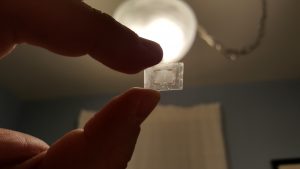 Once the metal frame is out, there is nothing holding the thinner glass element (letter B) other than friction. Gently push it out from the other side with your fingernail or a wooden toothpick and it should slide right out. I cannot stress enough how careful you have to be here not to crack this piece of glass. The image to the left shows this piece of glass before I cleaned it. Notice there are 4 silver frame lines on the glass. Be careful not to rub these off. I used a soft cotton rag and a small amount of rubbing alcohol to clean mine.
Once the metal frame is out, there is nothing holding the thinner glass element (letter B) other than friction. Gently push it out from the other side with your fingernail or a wooden toothpick and it should slide right out. I cannot stress enough how careful you have to be here not to crack this piece of glass. The image to the left shows this piece of glass before I cleaned it. Notice there are 4 silver frame lines on the glass. Be careful not to rub these off. I used a soft cotton rag and a small amount of rubbing alcohol to clean mine.
Next, you will want to clean the middle elements (indicated by the letter D). This middle element is sandwiched between two metal frames, one of which is slightly curved to put tension on it, and the other I’m not really sure what it does. But nevertheless, all three pieces come out together. You should be able to fit your fingers in there and slide them out all at once. If your fingers are too big, get someone with smaller hands to help you! 🙂
With B, C, and D out, you should have easy access to the inner surface of the outer element (letter A), so you should have no problem cleaning it with a Q-tip. At this point, you also have easier access to the beamsplitter so you can double check to make sure it is clean.
You’ll notice a thick rectangular metal frame in between letters C and D in the image above. This frame does not need to be cleaned and is not removable, so leave it alone.
Once everything is clean, you reassemble everything in the opposite of how you took them apart. Slide all 3 parts of the middle element (letter D) back into the camera in the same orientation that they came out. I found it easier to slide the thin outer glass element (letter B) and the curved metal frame (letter C) in at the same time. It’s hard to explain, but you “roll” the curved metal frame into the camera while pushing it and the glass at the same time. Be careful not to crack the glass.
Once everything is back into position, look through the rear viewfinder to make sure everything looks OK and everything is clean. If you haven’t cleaned the rear element or the rangefinder prism yet, this is the time to do so.
Assuming everything is OK, put both of the black metal brackets that were on top of the rangefinder assembly back. Screw them down so they don’t move. Replace the rear element and its frame if you still have them out. Finally, put the entire assembly back onto the camera and screw in it’s two screws securing it to the camera.
Before reattaching the top plate, look underneath it, and you’ll see glass covering the exterior windows. Clean these too.
Once you are sure everything is clean, reattach the top plate. If the frame counter button fell out when removing the top plate, you’ll need to put it back into position before reattaching the top plate. This button sits on top of a spring and can only go into the camera in one orientation. It will not line up with the hole in the top plate if you have it out of position, so you should easily be able to figure out how it goes in just by looking at it.
Once everything is screwed down tightly, look through your nice and clean viewfinder and assuming your camera needs no other work, load in a roll of film and go shooting!
My Thoughts
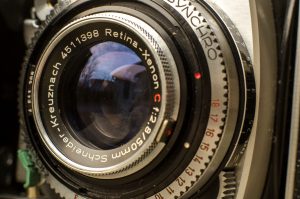
When you own both a IIa and IIc, it is hard to pick a favorite. I think that on display, the IIa looks a tad better than the IIc, and it has a faster f/2 lens (although many reviews online indicate that the f/2 and f/2.8 lenses are nearly identical other than max aperture setting), but the IIc feels to be better built and moves a lot easier.
The new door latch system on the IIc is easier to use than the older push button style on the IIa, but the potential downside is because it protrudes out of the front cover of the camera, it can get snagged on the inside of a camera bag, purse, or your pocket when putting it away or taking it out for use, so care must be given to not let that happen. Once the camera is in your hands, a quick push of the release latch and the door easily opens. Comparing my IIa and IIc together, I feel the IIc is easier and smoother to open, but to be fair, these are each 60+ year old cameras so they could have both been easy when they were new.
I only have the 50mm lens on the IIc, so I have no need to swap lenses, but to accomplish this, you must rotate a release from the white dot to the red dot to unlock the front element. Once that is done, it easily falls out of the camera. You can see the two dots on the image to the right.
Earlier, I talk about the lens having a new coupled light value scale which was designed to assist the photographer in picking an appropriate shutter speed and aperture combination, and although I completely understand how they were intended to work, I can honestly say I hate them. Not only that, but the Retina’s implementation of this feature isn’t easy to deal with either. I have a couple other cameras like the Aires 35-III L and Flexaret VII that have a similar feature, and I don’t like it on those cameras either.
The basic idea with this light value system is that you would use an external meter or knowledge of the lighting of a particular scene and come up with an EV value. For example, if you were shooting outdoors on a bright and sunny day, and your meter told you that you needed EV15, you would rotate the scale on the Retina to 15, and you would have perfect exposure regardless of what your shutter speed or aperture setting was. You would still be free to rotate the shutter speed dial, but the light value scale would lock aperture to whatever is appropriate for that lighting situation, so as you select a faster shutter speed, the camera would automatically pick a larger aperture. This system would lock you out of shutter speed and aperture combinations that either would be inappropriate for the lighting, or ones that the camera wasn’t physically capable of.
While it would seem that simplifying the light metering process by requiring the photographer to only select a single EV number as opposed to both a shutter and aperture setting, there are two major flaws with this system. The first is that its not easy to do with the camera to your eye. The EV system has a lever that “locks” the system in place. This lever is on the bottom of the front of the shutter and is very small. It’s plausible that after years of familiarity with this Retina, you could get used to feeling for it while shooting, but its not easy to do. I found that in every case, I had to pull the camera away from my eye and look at the front of the camera to change the EV value. This is a hassle if you are shooting somewhere with constantly changing light. It would have been so much easier to use the Sunny 16 rule and set your shutter speed to a fixed speed, and only change aperture sizes on the fly.
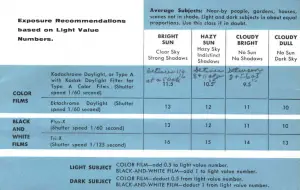
The second major flaw with an EV system like this is that the EV numbers change depending on the speed of film you are using. EV 15 on ASA 10 Kodachrome from the 1950s is not the same as EV 15 on modern day 100 and 400 speed films. A photographer could potentially memorize the EV scale for each lighting situation, but they’d have to consistently use the same type of film because the numbers would change with a different speed of film.
The image to the left is page 21 of the original manual for the Retina IIc and shows how specific the conditions must be for these numbers to mean anything. Anyone wanting to learn more about EV values can find interpretations of a chart like this using modern film speeds, but there is also something called LV, or Light Values, which isn’t the same thing as EV further adding to the confusion. Ken Rockwell does a nice job explaining the difference between LV and EV on his site.
This EV system was clearly designed before exposure meters were common on cameras, and also at a time when there were far fewer film speeds to choose from. Like I said earlier, I understand what it was intended to do, but now we have the benefit of hind sight to tell us that there are much better options to help simplify selecting the correct exposure settings.
This wouldn’t be so bad if this EV system could be disabled, but it cannot. The pin on the bottom of the shutter is always in the locked position and requires you to pull it away from the shutter ring to move it. If you do not do this, the shutter speeds and aperture sizes are always coupled together. This is hands down my least favorite aspect of using this camera and one reason I might still prefer the IIa over this camera as it does not have this type of system which is a shame because in almost every other way, the IIc is superior to the IIa.
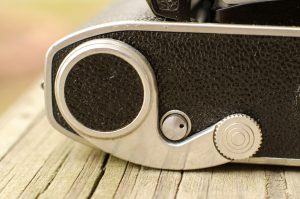
Another pretty major change between the IIa and IIc is that the film advance lever is on the bottom of the IIc which is unlike most other cameras of the day. I found it to be neither better or worse than a top mounted design. It requires your thumb to be in a different position than had it been on the top, but in use it didn’t bother me. I had no problems advancing the film in one single stroke. This might be an issue for a child or someone with smaller hands, but for me, it was a non issue.
The rest of my comments are true of both the IIa and IIc and that is these are truly wonderful cameras. They are compact, easy to use, and create beautiful images. The shutter is extremely quiet so if you are shooting in loud conditions, it might be hard to hear when it’s fired, but that is not really a big issue because you can just “feel” it when it fires. The shutter release is extremely smooth and well designed that I never once worried if the shutter had fired or not while out shooting.
There is a huge group of collectors who specifically look for Retinas. Some collectors will go as far as try to acquire one of every single variant of the Retina. While I don’t think I’ll ever reach that level of Retina-hoarding, I definitely see the appeal of having more than one. As it stands now, I have an older Retina 119 that I plan on cleaning up and shooting with some day. Once that happens, I will post my thoughts on that as well.
My Results
Unlike some of my other recent reviews of less common cameras like the Certo Super Sport Dolly, Kuribayashi Karoron, or Kodak Monitor Six-20 where I feel as though I am providing some new information to people who might not familiar with those models, the Retina is a very well known and well documented camera with tons of reviews, and I really have nothing new to say that hasn’t already been said ad nauseam many times before.
I’ll plagiarize myself and quote something I said in my review for the Retina IIa:
I don’t think I could have gotten sharper or more colorful results from any of my other cameras. In fact, the Xenon 2.0 lens lives up to its claim as an extremely sharp lens, and combined with the ease of use of the Retina’s rangefinder, I found that more of my shots were perfectly in focus than on a typical roll (of any other camera)…
The same is true here. I used expired film in the Kodak IIc on a trip into Chicago on a warm February weekend and as predicted, I came back with a roll of great shots. The expired film added a bit of extra challenge, especially in the low light situations, but otherwise, I am very pleased with these results.
The images above represent only 10 of the roll of 24, and of the ones I am not sharing, several are different angles of the same shot, and only 2 were incorrectly focused which says a lot about the viewfinder and rangefinder of the Retina. Focusing the IIc was consistent with my experience focusing the IIa in that it is very easy to do. Neither Retina has a viewfinder as large and bright as the ones on the Canon P or Yashica Electro, but it is nonetheless very easy to use.
Despite my complaints about the Light Value Scale on the Retina IIc, it didn’t seem to affect my ability to shoot these images using Sunny 16. I did not use any type of external light meter on this entire roll. Every single shot you see was done using that rule. Sure, a couple are a tad under, but I think that has more to do with the expired film. I believe that had I used a fresh roll on these shots, the images would have come out nearly perfect.
So, there you have it. Is the Retina IIc better than the IIa? Like everything in life, yes, and no. I’d say that the build quality is a bit better and the design is supposedly more rugged which could mean that less IIcs will have problems today than the IIa but that is very hard to prove. I like that the bellows is not exposed, which means these cameras should not have any issues with light leaks. Although I am not a fan of the position of the door release, I think the door design is better on the IIc. I also appreciate the slightly larger viewfinder, but when it comes to looking at the shots, I would be hard pressed to say I can see any difference between the shots from this camera compared to the IIa. If you are in the market for a 1950s rangefinder, both the Kodak Retina IIa and IIc are amazing choices, and anyone who tells you that one is better than the other is just giving you their personal preference. Simply put, these are both really great cameras that exemplify people’s obsession with the entire Retina line.
My Final WordHow these ratings work |
You should always set your expectations pretty high any time you pick up a Retina, and for good reason. These are some of the very best cameras of the mid 20th century. They are compact, easy to use, and always have great optics. The Retina IIc is an improvement on the IIa in many ways, but it’s inclusion of the coupled EV ring is a huge annoyance that slows the process of shooting with it compared to the earlier IIa. It is a completely unnecessary feature that provides little to no benefit. Aside from this one aspect, this is a truly wonderful camera to shoot with. I am fortunate to have one that is in near mint condition and its a camera I plan on using again despite the annoying EV scale, although I think that if forced to choose between this or the IIa, I might prefer the IIa for it’s simpler design. On the other hand, being forced to choose between a Retina IIa and a IIc is a good problem to have! | ||||||
| Images | Handling | Features | Viewfinder | Feel & Beauty | History | Age | |
| 2 | 2 | 1 | 1 | 2 | 1 | 30% | |
| Bonus | None | ||||||
| Final Score | 11.7 | ||||||
Additional Resources
http://retinarescue.com/retina2ctype020.html
http://www.dantestella.com/technical/retina.html
http://camerapedia.wikia.com/wiki/Kodak_Retina_IIc
https://www.35mmc.com/05/04/2018/5-frames-kodak-retina-iic-howard-dale/
https://en.wikipedia.org/wiki/Kodak_Retina
http://photo.net/classic-cameras-forum/0083Fw
http://blog.bkspicture.com/review_Kodak_Retina_IIc.html
http://www.hookedonlight.com/2012/10/treasures-from-time-kodak-retina-iic.html

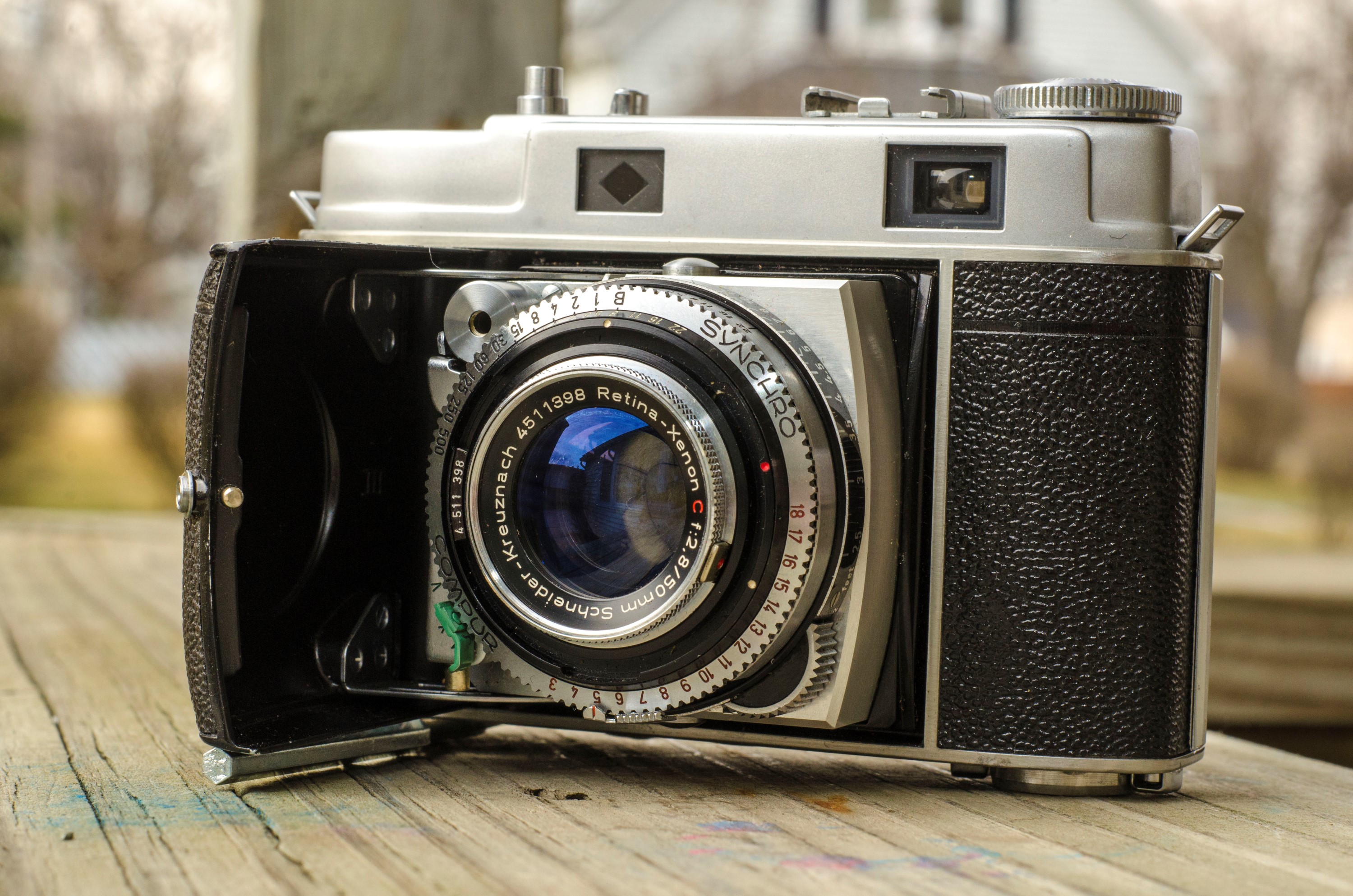
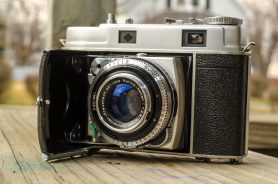
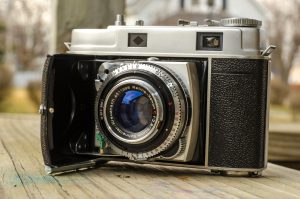
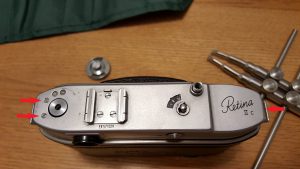










Loved learning more about this little gem. I found one in a box of old cameras from my grandpa.